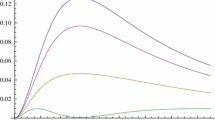Abstract
We consider static, spherically symmetric configurations of electrically charged dust in Einstein-Maxwell-dilaton gravity where the Lagrangian contains the interaction term P(χ)F μν F μν with an arbitrary function P(χ). Unlike previous studies, we assume that the scalar field χ (which can be canonical or phantom) does not have a charge of its own and exists only due to this interaction. We discuss possible solutions to the field equations, in particular, those describing black holes (BHs) and quasi-black holes (QBHs). The latter are globally regular configurations whose size is very close to that of a BH of the same mass and which therefore are almost indistinguishable from BHs for a distant observer. Some general features are revealed, a family of explicitly integrable models is found, and some explicit examples are presented.
Similar content being viewed by others
References
B. P. Abbott et al., Phys. Rev. Lett. 116, 061102 (2016).
Cecilia Chirenti and Luciano Rezzolla, “Did GW150914 produce a rotating gravastar?”, arXiv: 1602.08759
José P. S. Lemos and E.J. Weinberg, Phys. Rev.D 69, 104004 (2004).
José P. S. Lemos and O. B. Zaslavskii, Phys. Rev. D 82, 024029 (2010).
José P. S. Lemos and O. B. Zaslavskii, Phys. Lett. B 695, 37 (2011).
José P. S. Lemos, Scientific Proceedings of Kazan State University (Uchonye Zapiski Kazanskogo Universiteta (UZKGU)) 153, 215 (2011); arXiv: 1112.5763.
S. D. Majumdar, Phys. Rev. 72, 390 (1947).
A. Papapetrou, Proc. Roy. Irish Acad. A 51, 191 (1947).
K. A. Bronnikov, J. C. Fabris, R. Silveira, and O. B. Zaslavskii, Gen. Rel. Grav. 46, 1775 (2014); arXiv: 1312.4891.
K. A. Bronnikov, J. C. Fabris, R. Silveira, and O. B. Zaslavskii, Phys. Rev. D 89, 107501 (2014); arXiv: 1405.6116.
K. A. Bronnikov and O. B. Zaslavskii, Mod. Phys. Lett. A 30, 15550154 (2015); arXiv: 1504.07022.
I. Z. Fisher, Zh. Eksp. Teor. Fiz. 18, 636 (1948); grqc/9911008.
O. Bergmann and R. Leipnik, Phys. Rev. 107, 1157 (1957).
H. Ellis, J.Math. Phys. 14, 104 (1973).
K. A. Bronnikov, Acta Phys. Pol. B 4, 251 (1973).
R. Penney, Phys. Rev. 182, 1383 (1969).
K. A. Bronnikov and G. N. Shikin, Russ. Phys. J. 20 (9), 1138–1143 (1977).
G.W. Gibbons and K. Maeda, Nucl. Phys. B 298, 741 (1988).
D. Garfinkle, G. T. Horowitz, and A. Strominger, Phys. Rev. D 43, 3140 (1991)
M. Rakhmanov, Phys. Rev. D 50, 5155 (1994)
G. Clément, J. C. Fabris, and M. E. Rodrigues, Phys. Rev. D 79, 064021 (2009).
M. Azreg-Ainou, G. Clément, J. C. Fabris, and M. E. Rodrigues, Phys. Rev. D 83, 124001 (2011); arXiv: 1102.4093.
V. D. Ivashchuk and V. N. Melnikov, Class. Quantum Grav. 18, R87–R152 (2001); hep-th/0110274.
K. A. Bronnikov, V. D. Ivashchuk, and V. N. Melnikov, Grav. Cosmol. 3, 203–212 (1997).
V. N. Melnikov, Grav. Cosmol. 22, 80–96 (2016).
V. D. Ivashchuk and V. N. Melnikov, Grav. Cosmol. 22, 166–178 (2016).
K. A. Bronnikov, V. N. Melnikov, and G. N. Shikin, Russ. Phys. J. 21 (11), 1443 (1978).
K. A. Bronnikov, V. N. Melnikov, G. N. Shikin, and K. P. Staniukovich, Ann. Phys. (NY) 118 (1), 84 (1979).
T. Damour and A. M. Polyakov, Nucl. Phys. B 423, 532–558 (1994); hep-th/9401069.
T. Damour and A. M. Polyakov, Gen. Rel. Grav. 26, 1171–1176 (1994); gr-qc/9411069.
K. A. Bronnikov and S. G. Rubin, Black Holes, Cosmology, and Extra Dimensions (World Scientific, 2012).
Author information
Authors and Affiliations
Corresponding author
Rights and permissions
About this article
Cite this article
Bronnikov, K.A., Israpilov, D.I. Dilatonic (quasi-) black holes without scalar charge. Gravit. Cosmol. 22, 281–287 (2016). https://doi.org/10.1134/S020228931603004X
Received:
Published:
Issue Date:
DOI: https://doi.org/10.1134/S020228931603004X




